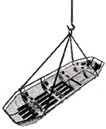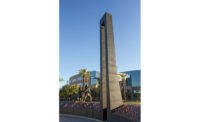 N
NTo find him, firefighters, police and construction workers in the rescue team had to forget about tons of cracked slab and uncured concrete balancing over their heads. They had to keep their minds off the weak-ened columns and wall looming over the debris. And they had to hope that gravity had taken the rest of the morning off.

|
| Desperate Hours. Firefighters and workers during the early phases of the search. (Photo by Scott Stetzer/The Press of Atlantic City) |
Fears Ignored
Dozens of rescuers who pulled the wounded and dead out of the debris at the Tropicana Casino and Resort in the first two hours after the accident were aware of the danger of another collapse, but chose to ignore it. Despite uncounted acts of heroism, the operation was a bittersweet success. Four workerstwo cement masons and two ironworkersdied, and 24 others suffered injuries, including four who were hospitalized in critical condition. Many are unlikely to work again because of those injuries.
What happened in the first 22 hours after the accident has never been told in detail. There is much to learn about how a smooth-running rescue and recovery operation accounts for the missing, taps resources in a crisis and avoids wasteful turf battles when every minute counts.
As a mobilization of community services, everything seemed to go right. The first phase saw local firefighters, operating under a widely used command structure, rush to free the injured and lightly trapped workers. They called for every tool available and enlisted unharmed construction workers to search and shore shaky parts of the wreckage. Local firefighters eventually handed the lead role to the states urban search and rescue task force, which also used construction workers, engineers and others to perform specialized tasks and provide information.
Atlantic City has only 40,000 permanent residents so shared links of family and friends were common among those involved on the project and in the rescue. Disputes never flared and everyone pitched in. A local bank allowed its office to be used as a command center; the Home Depot in nearby Absecon, N.J., sent 4 x 4 wood posts that were used for shoring; and Roma Steel in Camden donated wire that was used for tiebacks and bracing. Many in-dividuals, such as a crane operator who ferried people around the wreckage, worked into the night. What follows are some of their stories.

|
 |
 |
| Wounded Structure. Slabs slowed the search until a displaced beam (right) was tied back. Engineers and ironworkers confer (bottom). |
The First Call
Levon S. Clayton is a battalion chief in the Atlantic City Fire Dept. He was at department headquarters working on routine paperwork when his radio crackled to life at 10:38 a.m. with a call reporting a building collapse at the Tropicana Casino and Resort, one of the citys largest resort-casinos, which was undergoing a $245-million expansion. Although he did not know it at the time, the top five floor slabs in a bay of the hotels concrete garage, being built atop an existing structure, had suddenly lost support at one end and hinged downward like cards in a Rolodex file. About 50 workers were in and aroundthe garage section. Clayton called for another ladder company and asked the citys director of emergency services to respond. He then headed for the Tropicana.
When Clayton arrived, he saw a large group of construction workers on Brighton Avenue outside the garage looking up at the wreckage. "I grabbed one guy and said, get all the trade foremen," Clayton says. The man said he was one. Clayton then told him to "get all the workers up here and get a head count so we know how many are missing." The foreman disappeared and was not seen again.
A security guard informed Clayton that there were many injured workers and roughly described their locations. Clayton assigned various fire companies to begin removing surface victims, the injured and those who were "lightly trapped" and could be immediately given first aid and "packaged" for transport to a local hospital. He also put Capt. Scott Evans of Ladder Co. 2 in charge of the search. Evans is a trained member of a special state rescue task force whose services might be needed later.
![]() click here to view story - New Jersey Rescue Team Engineer Worked to Prevent Second Collapse
click here to view story - New Jersey Rescue Team Engineer Worked to Prevent Second Collapse

|  |  |
| Rescue professionals. Mooney (left) and Clayton (middle) played key coordinating roles as Engine Co. 6 members waded into the debris to find hurt workers. (Photos by Richard Korman for ENR) | ||
The same call that came to Clayton also reached Capt. Michael Mooney, a headquarters staff member at another fire department facility in downtown Atlantic City. He saw a dust cloud rising from the Tropicana a mile away. When Mooney arrived, Deputy Fire Dept. Chief Lewis Jaynes instructed him to run the departments command post at the scene, which turned out to be the hood of Jaynes Jeep. "We called for help right away," including extra equipment and ambulances, says Mooney.
Mooney, who 30 years earlier briefly worked for the projects principal subcontractor, Fabi Construction Inc., Egg Harbor Township, took up the task of counting the missing. He instructed a police sergeant on the scene, his brother, to find the union shop stewards. Mooney wanted the stewards to assemble their jobsite workers at the intersection of Brighton and Atlantic avenues, a block away from the collapse but with a clear view of the wreckage.

|
In the minutes following the collapse, Will Pauls, business manager of ironworkers' Local 350 and president of the South Jersey Building and Construction Trades Council, received a phone call from the ironworkers union steward on the job, who told him what had happened. Pauls headed straight to the Tropicana and joined the gathering workers. "The first thing youre thinking is that your members could still be alive and every minute that is going by is essential," says Pauls.

|  |
| Rescue Resource. Ironworkers (above, bottom left) pitched in by bracing and shoring the structure and Will Pauls (far right) waits with city official as search for missing drags on. | |
Some of the first firefighters Clayton ordered into the building were from Ladder Co. 2. Finding themselves blocked from the garages top level by debris, they climbed makeshift ladders and pieces of debris to search for trapped workers. Collapsed floors had deposited about 15 workers on the roof of an adjoining breezeway building and another 10 or so on the fifth level of the garage, at the base of a wall.
The "tub," as some firefighters called this space, was a nightmarish vision of bleeding and stunned workers imprisoned by rebar and slathered with freshly poured concrete. Looming over them were several wobbly concrete columns and a section of stranded wall that remained eerily upright above the wreckage. Firefighters were aware that these structures could fall. If there was another collapse, "we were dead," says Tucker Smith, a firefighter whose son was a carpenter at work in the building.
On the roof of the adjoining breezeway building, Evans asked some construction workers to move away so firefighters could lower themselves to the victims. "Climbing into the lower collapse area, we untangled the first worker and handed him up to another worker," Evans wrote in an account of his activities. "The next worker was pinned in the standing position with broken legs and rebar wrapped around his waist and foot."
As some firefighters held the worker upright, others used a metal saw and pry bar to free his body from the rebar. He then was placed in a stokes basket and carried out through the jumble of debris to the roof of the adjoining building, where many of the injured had either fallen or fled to during the collapse. There, they briefly were...
ot even dangling concrete slabs and the danger of another collapse could keep the firefighters from finding and digging out Jimmy Bigelow. At 29, he was the top apprentice who graduated in 2003 from a training program operated by ironworkers Local 350 in Atlantic City, N.J. Now he was buried in the pieces of a casino-resort garage bay that shattered on the clear morning of Oct. 30, 2003.


Post a comment to this article
Report Abusive Comment